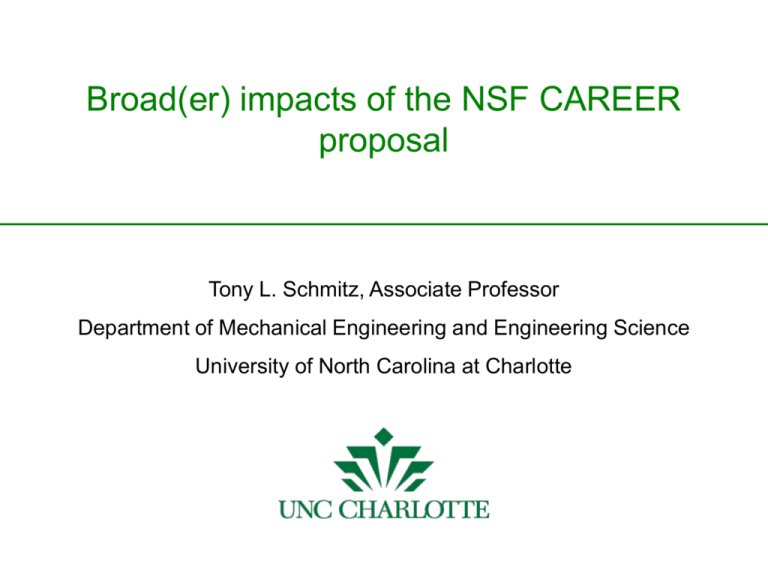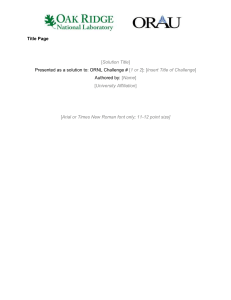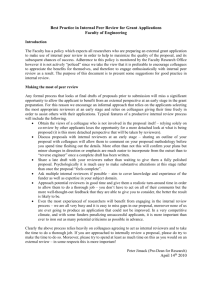Presentation by Dr. Schmitz
advertisement

Broad(er) impacts of the NSF CAREER proposal Tony L. Schmitz, Associate Professor Department of Mechanical Engineering and Engineering Science University of North Carolina at Charlotte Broader impacts If you are thinking about writing your CAREER proposal, then you’ve been studying the Grant Proposal Guide (GPG) and are familiar with… http://www.nsf.gov/pubs/policydocs/pappguide/nsf11001/gpg_3.jsp#IIIA2 Broader impacts I’m not actually going to talk about NSF proposal merit review criteria, however. I’d like to tell you about the broad(er) impact that the NSF CAREER program has had on my academic career. Agenda Introduction CAREER proposal broad(er) impacts Writing your CAREER proposal Conclusions Agenda Introduction CAREER proposal broad(er) impacts Writing your CAREER proposal Conclusions Introduction Education 1990 BS Temple University 1993 MS University of Florida 1996 PhD University of Florida 1999 1995 Appointments Assistant football coach, Fort Scott Community College, Fort Scott, KS, 1993 Engineer, Acme Foundry, Coffeyville, KS, 1994 Guest researcher, LLNL, Livermore, CA, 1996 2000 NRC post-doctoral research associate, NIST, Gaithersburg, MD, 19992002 Lecturer, Johns Hopkins University, Baltimore, MD, 2000-2002 Assistant Professor, University of Florida, Gainesville, FL, 2002-2007 Associate Professor, University of Florida, 2007-2011 Associate Professor, University of North Carolina at Charlotte, 2011present 2005 Defensive coordinator, Weddington HS, Weddington, NC, 2011-present CAREER proposal Submitted July, 2002. Awarded March, 2003. 2010 Agenda Introduction CAREER proposal broad(er) impacts Writing your CAREER proposal Conclusions CAREER proposal broad(er) impacts That very special (award) telephone call from your program manager (George Hazelrigg for me) has a few effects: • it reduces the tremendous pressure you (probably) feel as a new faculty member • it means you get to/need to hire students • you now have to actually do the work that you proposed! CAREER proposal broad(er) impacts In my case: • I proposed an approach to predict the tool point dynamics for toolholder-spindle-machine assemblies • purpose was to enable pre-process selection of optimal machining parameters • CAREER funds enabled me to: 1. hire students (one is now a professor at Valparaiso University, another is a professor at Penn State Altoona, REU student later completed his PhD and is now post-doc at NIST, another REU student is in medical school) 2. equip my laboratory (Machine Tool Research Center at UF) • infrastructure enabled new projects to be pursued • improved student recruitment • developed sustainable research program 3. travel (conferences and industrial research partners) • ASPE – annual conference chairman, board of directors • NAMRC – best paper award, scientific committee CAREER proposal broad(er) impacts • CAREER funds enabled me to: 4. develop courses • Structural Dynamics of Production Machining – co-authored textbook with Dr. Scott Smith, UNC Charlotte • Mechanical Vibrations – co-authored textbook with Dr. Scott Smith 5. pursue patents based on research activities • Flexure-Based Dynamometer for Cutting Force Measurement, D. Burton, T. Schmitz, G.S. Duncan, and J. Ziegert, US Patent No. 7,536,924 • Variable Tuned Holder for Machine Tools, T. Schmitz, B. Mann, and K.S. Smith, US Patent No. 7,730,813 B2 • System and Method for Tool Point Prediction Using Multi-Component Receptance Coupling Substructure Analysis, T. Schmitz and G.S. Duncan (allowed) Chip off the old block 6. perform local outreach activities • SSTP – mentored HS student who later graduated with BS in ME • hosted student visits to laboratory • completed laboratory service projects CAREER proposal broad(er) impacts • CAREER funds enabled me to: 7. develop educational videos • Pigskin Professor – series of videos that describe engineering fundamentals in the language of football. This was a collaboration with the Digital Worlds Institute at the University of Florida and was funded by my NSF CAREER award. http://www.digitalworlds.ufl.edu/news/pigskin/media.asp# • The Science of NFL Football – I served as the science advisor (on George Hazelrigg’s recommendation) for the Emmy award winning “Science of NFL Football” video series, a collaboration between the National Science Foundation, NBC Learn, and the National Football League (NFL). This 10part video series: 1) explored concepts from physics, biology, mathematics, chemistry, and engineering; and 2) demonstrated how these concepts are integral to football. http://www.nbclearn.com/portal/site/learn/science-of-nfl-football 8. help commercialize the research • Manufacturing Laboratories, Inc. recently received a DARPA Phase II SBIR for the Machine Tool Genome Project http://www.youtube.com/watch?v=AtJ_OuwqueY&NR=1 CAREER proposal broad(er) impacts Machine Tool Genome Project Milling models enable pre-process parameter selection and optimization, but can be challenging to implement on the shop floor. For example, stability lobe diagrams offer selection of chatter-free process parameters. How are they computed? Depth Vibration response at the tool point (frequency response function, or FRF) Spindle speed The FRF for each machine-spindle-holder-tool combination is required. Impact testing is the typical experimental choice. CAREER proposal broad(er) impacts Why is this a problem? • There are 3053 models of CNC machining centers from 229 builders1. • Milling tools from 110 manufacturers and milling tool holders from 72 manufacturers are available1. • Assuming an average of 500 stock keeping units (SKUs) from each cutting tool manufacturer and 100 SKUs from each tool holder company, there are over 1.21012 potential tool-holder-machine-material combinations, where each toolholder-machine assembly has its own unique tool point FRF. This scenario calls for an approach that can predict the tool point FRF for arbitrary tool-holder-spindle-machine combinations using minimum input information. 1,200,000,000,000 dynamic “fingerprints” 1http://www.techspex.com, accessed June 2, 2010. CAREER proposal broad(er) impacts This problem is analogous to the Human Genome Project: • international scientific research effort • determine the sequence of chemical base pairs which make up DNA • identifying and mapping the 20,000 to 25,000 genes of the human genome • launched in 1990 • completed in 20032,3. In the Machine Tool Genome Project: • the “genes” are the tool, holder, and spindle-machine • the “mapping” is performed using Receptance Coupling Substructure Analysis (RCSA) to predict the tool point frequency response, i.e., the “body characteristic”. • the spindle-machine “genes” are measured once and archived • the desired tool and holder “genes” are modeled. Based on the predicted tool point FRF, preferred operating parameters are selected which respect the limitations imposed by the process dynamics. 2Barnhart, 3DeLisi, B.J., 1989, DOE Human Genome Program, Human Genome Quarterly, 1:1. C., 2001, Genomes: 15 Years Later A Perspective by Charles DeLisi, HGP Pioneer, Human Genome News 11:3-4. CAREER proposal broad(er) impacts 1. Determine spindle-machine FRF using standard holder4. F Archive spindlemachine FRF. + X Gene 2. Model tool and holder. + + + = Gene 3. Couple tool-holder model to spindle response and predict tool point FRF. Mapping Body characteristic + 4. Use tool point FRF to predict milling process behavior and optimize process. 4Schmitz, T., and Duncan, G.S., 2005, Three-Component Receptance Coupling Substructure Analysis for Tool Point Dynamics Prediction, Journal of Manufacturing Science and Engineering, 127/4: 781-790. Agenda Introduction CAREER proposal broad(er) impacts Writing your CAREER proposal Conclusions Writing your CAREER proposal You’ll want to communicate your research/education vision. This will include leaving reviewers with a clear idea of your vision after reading your proposal. They will be able to answer the following questions. 1. Why are you going to carry out this research? 2. How will the research results be applied? 3. What makes your research objectives unique? A first question you’ll want to answer before you begin writing is ‘Why am I going to carry out this research?’. The purpose of the CAREER proposal is to jump-start your career. A best answer is probably not ‘so I can get funded and hopefully get tenured some day’. Writing your CAREER proposal Why clearly communicating your vision is important… I’ve reviewed and read proposals for colleagues that were good, but didn’t leave me too excited about their plans. Given the competitive nature of the CAREER proposal, “good” proposals are not always funded. Your job is to convince the panel of reviewers that your research will improve the state-of-the-art and will have broader impacts. How do you do this? Tell a compelling story… Lead the reviewers down your path. Be the pied piper… Writing your CAREER proposal Be a story teller. Remember, this is not a research paper. You’ll want to do more than just ‘report the facts’. Provide compelling justification for why your selected research area is important (e.g., can you provide a sound economic justification for your plans?). • Do your homework. Report previous efforts. • Talk to people in the industry (more on collaborators later). Ensure that those not familiar with your research area can follow your story. • Don’t be too quick to jump to the “equation section”. Of course you’ll want to demonstrate the scientific/mathematical rigor or your proposed research, but… • if the reviewers are not clear about why you are proposing this work, they may not give the technical section the attention it deserves. Writing your CAREER proposal Make sure your proposal is not a bed-time story! You’ll want your story to generate some excitement among the reviewers. Successful proposals often leave the reviewers saying ‘Gee, I wish I’d have thought of that’ when they are finished reading. How do you do this? Be brave: • propose significant leaps in the state-of-the-art • I have a hard time describing research that I’m not exactly sure that I can complete… • however, a comprehensive research plan will give reviewers confidence in your objective. Writing your CAREER proposal A strong research plan: • establishes a logical, chronological plan of activities that will lead you to your research objectives. I separated my proposed research into stages that corresponded to particular years of the five-year plan. • identifies clear success metrics. Let the reviewers know how you will decide if your research is on the right track. • identifies major questions that must be answered. Don’t be afraid to say ‘What if x doesn’t work?’, but provide a plan of action if this occurs. • defines relevant collaboration. Writing your CAREER proposal Collaborators: • identify relevant collaborating organizations • get the right person on the phone • make your pitch. If you can convince him/her that they should get on board your “research train”, then maybe you will probably convince the reviewers also. If you can get the collaborators to provide some support, reviewers will be impressed. You will have established credibility for your research. Examples include: • materials and supplies • equipment (great to go after – hard to get this money) • engineering support. Writing your CAREER proposal Don’t leave your education plan as an afterthought. It is a critical component of your CAREER proposal. It is best if your education plan takes a unique approach to outreach in education and is integrated with your research plan (not completely separate). While the following activities are natural for faculty members: • offering a new graduate course • teaching undergraduate courses x, y, and z • participation in undergraduate engineering societies an excellent education plan is also part of your proposal vision and may include components outside these traditional activities. What interests you? What are your talents? How can you apply them to innovative education? Writing your CAREER proposal Prior to CAREER submission, a NIST colleague critiqued my proposal and said: There is nothing exciting in your education plan. You will not get funded. Not fun to hear, but it set me to thinking. What do I like? • football • engineering. This led to the Pigskin Professor video concept – presented engineering concepts in the language of football at the 2003 UF home games. Writing your CAREER proposal Reviewers must evaluate your proposal based on two main criteria: • Intellectual merit • Broader impacts. Spend some time thinking about how you can uniquely address these criteria. In addition, there are particular questions the reviewer must address. For example, reviewers are asked to: evaluate the scientific quality and importance of the proposed research and education activities, the objectives and significance of these activities, and the capability of the applicant to make an integrative contribution in both education and research. It is helpful to reviewers if you don’t make them search for answers to these questions. It is also important to proofread. Don’t let grammatical, style, or formatting errors obscure your great ideas. You might as a non-technical colleague to edit for these errors. It is also help to include relevant, high-quality graphics. Use figures to support your story. Agenda Introduction CAREER proposal broad(er) impacts Writing your CAREER proposal Conclusions Conclusions Winning the CAREER award can have “broad impacts” on your faculty career. It is worth the effort required to write an excellent proposal. An excellent CAREER proposal tells the reviewers about you as a complete package. This includes your: • research plan • education plan • prior experience and future potential. The reviewers’ task is to predict your chances for future success and your ability to make an impact in your field. Give them the ammunition they need to enthusiastically support your proposal. To summarize: 1. have a vision 2. tell your story 3. be innovative in your combined research and education plan. Good luck! Contact information Tony Schmitz University of North Carolina at Charlotte Email: tony.schmitz@uncc.edu Telephone: (704) 687-8421 Web site: http://coefs.uncc.edu/tschmit4/


